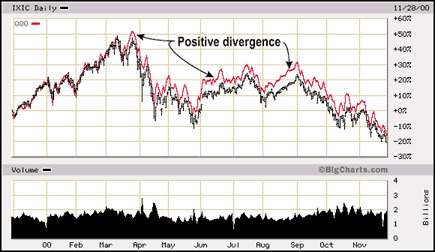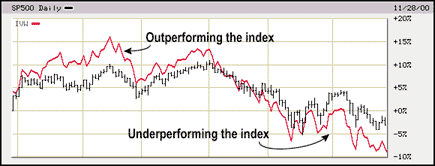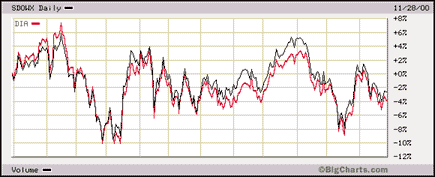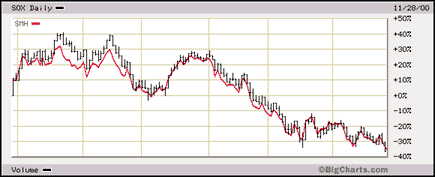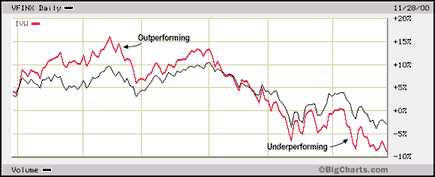
HOT TOPICS LIST
- Strategies
- Stocks
- Buy
- Investing
- Brokers
- Psychology
- Interviews
- Accumulate
- Sell
- Hold
- Spotlight
- Websites
- Candlestick Corner
- Gold & Metals
- Options Trading
LIST OF TOPICS
INVESTING
Easing Into Exchange Traded Funds
01/26/01 11:55:33 AM PSTby David Penn
Stock "baskets" and exchange traded funds are the new investment vehicles on the block. Can they help you meet your investment goals?
| Face it: When it comes to buying shares in individual companies, you're just plain lost. Time and time again, you buy a stock when its price is near a top, and it seems like every time you sell, the stock barely looks twice before hurdling over the price you sold at and bounding up toward new highs. But when it comes to the market as a whole -- the Dow Jones Industrial Average (DJIA), the Nasdaq Composite, the Standard & Poor's 500 -- it seems as if you always know which way the wind is blowing. "If only I could trade the whole dang market, "you think, only half in jest, "instead of all these little parts!" Well now, thanks to the explosive growth in exchange traded funds, you might be able to do just that. There is a little bit of the old and the new when it comes to exchange traded funds, which are collections of stocks that are bought and sold as a package on an exchange, principally the American Stock Exchange (AMEX), but now the New York Stock Exchange (NYSE) and Chicago Board Options Exchange (CBOE) as well. Individual and institutional investors have been trading closed-end funds and unit investment trusts since the beginning of equities investing. But the dramatic rise in the number of investors in stock mutual funds in the 1990s, combined with the increasing sophistication of the average investor and ready access to financial information on the Internet, put many investors in a squeeze. Many individuals wanted the diversification of a collection of stocks but also wanted the freedom to move more nimbly into and out of their funds as the economic climate changed. The exchange traded fund was the answer. An exchange traded fund acts very much like both a mutual fund and an individual share in a stock. Like a mutual fund, exchange traded funds (ETFs) consist of anywhere from 10 to 50 different equities and offer an easy road to diversification for many investors who would rather not do the work of selecting up to 50 different stocks on their own. At the same time, ETFs -- like individual stocks -- can be bought on margin, traded on an intraday basis, and even sold short without the uptick rule (that is, when shorting stocks, an investor or trader must wait for prices to move up one tick before they can sell borrowed shares). What ETFs all offer is the opportunity to trade and invest in entire sectors of the economy with the ease and facility of moving individual stocks. Says John Roberts, director of marketing at Barclays Global Investors, creators of exchange traded funds called iShares, "Until now, investors only had a limited set of investment vehicles to choose from." (See Working Money's interview with John Roberts elsewhere in this issue.) With ETFs, all that has changed. POCKETS OF STOCK The original exchange traded funds are the Standard & Poor's depositary receipts, often referred to as "spiders" because of their acronym, SPDR. SPDRs are an exchange traded unit investment trust that consists of a fixed portfolio of stocks based on the S&P 500 index. Investors purchase shares in the trust, shares that are priced initially at a tenth of the value of the S&P 500 index. Thus, if the S&P 500 were trading at about 1300, an investor could expect SPDRs to be trading around $130. However, the value of SPDRs changes as market conditions change, responding to dividend payouts as well as supply and demand. The goal of SPDRs is to match the price and yield performance of the Standard & Poor's 500 index. SPDRs, like virtually all exchange traded funds, are traded on the American Stock Exchange (AMEX). There are several different kinds of SPDRs, in addition to the SPDR that tracks the S&P 500. Basic industry, energy, financial, technological, and utility companies are some of the economic sectors that individuals can invest in through SPDRs. If there are exchange traded funds for the S&P, then there must be similar funds for the DJIA and Nasdaq, right? Absolutely. The Dow Jones' ETFs are referred to as "diamonds" and are also traded on the American Stock Exchange. Unlike SPDRs, there is only one diamond exchange traded fund. It seeks to provide returns that are similar to the performance of the DJIA. Similarly, the Nasdaq has a sole exchange traded fund. The Nasdaq 100 Index Tracking Stock attempts to match the price and yield performance of the Nasdaq 100 Index, and is known (at times affectionately, at other times not so) as "the cube" for its trading symbol, QQQ. Like SPDRs, both cubes and diamonds are structured as unit investment trusts. This means, among other things, that dividend payouts from the trust are not automatically reinvested into buying additional shares, as is the case with both Select sector SPDRs and iShares, discussed shortly. Two newer exchange traded investment products are Merrill Lynch's holding company depositary receipts (HOLDRs) and the iShares offered by Barclays Global Investors. iShares provide investors with more than 50 different indices, which can be traded or invested. Because of the variety of iShares available, it is easy for holders to diversify by investment style, market sector, geographic region, and a number of other categories. Like SPDRs, diamonds, and cubes, iShares are purchased through brokerages, and are traded on the AMEX. Although iShares them-selves are a relatively new investment vehicle, Barclays Global Investors has been providing exchange traded funds since 1996, when it began offering World Equity Benchmark Shares (WEBs) for investors seeking international exposure. Since then, Barclays has developed a veritable fleet of ETFs; the company provides 11 different S&P iShares, 15 Dow Jones sector iShares, 21 international iShares based on the widely used Morgan Stanley Capital International (MSCI) indices, and three small-cap iShares based on the Russell 1000, 2000, and 3000, with more to come. Merrill Lynch's entry into the exchange traded fund market consists of its HOLDRs, which allow investors to own a preset portfolio of stocks (or American depositary receipts, for international companies). One major differ-ence between HOLDRs and most exchange traded funds is that HOLDRs do not seek to replicate a specific benchmark, such as the S&P 500 or the Nasdaq Composite. Instead, HOLDRs consist of a fixed "basket" of stocks that together represent a sector such as biotechnology, utilities, or semiconductors. As such, unlike most other ETFs, HOLDRs are redeemable -- for a small fee -- for the actual underlying stocks, which provides some flexibility for active, individual investors. For example, if one of the underlying stocks in a HOLDR is underperforming, an investor can elect to redeem the HOLDR for a fee of about $10 per round-lot (a round-lot is 100 HOLDRs; and HOLDRs are only available in round-lots) and, upon having all of the shares of the HOLDRs deposited in his or her account, sell the poor performer. The actual selection of underlying stocks in the HOLDR is based on a number of criteria -- including market capitalization, liquidity, P/E ratio, and others -- and the composition of the Holdr is determined in advance of the HOLDR's initial public offering (IPO). Currently, Merrill Lynch offers 12 different HOLDRs, ranging from offerings in biotechnology and Internet infrastructure to regional banks and pharmaceutical interests. POCKETS OF PERFORMANCE Just how well do some of these exchange traded funds keep up with their respective indices? How well do ETFs perform relative to index mutual funds, for example, which are often tracking the same indices? And how well do different ETFs fare on a fee-adjusted basis when compared to index mutual funds, which are famously inexpensive ways to invest? As Figures 1 and 2 suggest, ETFs that track major indices, such as QQQs, tend to do a good job of adhering to their benchmarks. The price action of the QQQ, for example, is almost indistinguishable from the price movement of the Nasdaq Composite itself.
Beyond even this newest crop of exchange traded funds lies the world of stock baskets, led by companies like Foliofn. Foliofn provides investors with the ability to create their own personalized portfolios of stocks. Investors can own more than one folio, as the portfolios are called, and can choose predesigned portfolios based on market sector and risk level. More enterprising investors can select up to 50 stocks for a completely personalized portfolio. Foliofn's website offers tools for balancing and rebalancing portfolios in response to additions and changes in the value of different holdings, as well as a number of other features such as charts and tax planning applications to help folio investors stay informed about the status of their holdings and help them reduce exposure to taxes as a result of capital gains. Foliofn charges $29.95 a month or $295 a year to maintain investors' folios, with no additional charges. Foliofn executes trades for investors' folios during two "window-trading" periods each day -- one in the morning and the other in the afternoon. Buy and sell orders that match within the Foliofn investor population are executed at prevailing prices without being taken to market, which Foliofn notes is a significant source of cost savings. All other orders are sent to the market to be filled. There are no minimum account levels and no minimum or maximum trade limits. While Foliofn's $29.95 a month can be significantly less expensive than the average stock mutual fund (which averages between 1.2% and 1.3% in fees), savings alone may not be the best reason to select Foliofn. As with the exchange traded funds discussed earlier, investors opting for simplicity over flexibility may still prefer an index mutual fund pegged to the S&P 500, realizing a cost savings over a similar approach using folios. (The annual expenses of a $10,000 account in Vanguard's S&P 500 index mutual fund come to about $17.) But for those interested in trading shares, playing a more active role in building their investment portfolio, and keeping costs down, Foliofn represents significant cost savings over similar services and products offered at traditional brokerage houses. ARE EXCHANGE TRADED FUNDS FOR YOU? Christopher J. Traulsen, who is a senior analyst at Morningstar.com and director of ETF research, considers exchange traded funds a "great development" for low-cost investing, even if ETFs are no panacea for average investors. "Exchange traded funds are a useful tool," Traulsen notes, "but they can be expensive to own." Depending on an investor's buying and selling habits, the commissions on even the least-expensive exchange traded funds, such as iShares S&P 500 funds, can add up. This can be especially the case for investors who use dollar-cost averaging on their additions, buying more ETF shares on a regular basis (monthly or quarterly). Others see ETFs as an investment product likely to give open-end mutual funds a run for their money. Mary Rowland, a writer for MSN Money Central and author of The New Commonsense Guide To Mutual Funds, has all but declared the open-end mutual fund dead and buried, predicting that "the open-end mutual fund as we know it will be an antique in five years" and, moreover, "managers of open-end mutual funds know the time is running out." True enough, Vanguard Funds -- a fund family that has become virtually synonymous with index mutual fund investing -- has filed with the Securities and Exchange Commission (SEC) to register VIPERs, its own fleet of exchange traded funds. While this move is likely to help Vanguard earn new business from investors looking to take advantage of the trade-friendliness of ETFs, it is also likely that the move will help owners of Vanguard's index mutual funds by moving active traders -- whose constant darting in and out of mutual funds is the bane of money managers nationwide -- out of Vanguard's index mutual funds and into a more appropriate investment environment. Should exchange traded funds be a major part of your investment portfolio? Depending on your goals, ETFs can deliver much the same performance as index mutual funds (though at present, Foliofn's folios cannot be used as part of 401(k) plans). So if you have considered using index mutual funds to reach an investment goal and find yourself attracted to exchange traded funds, there is a growing array of ETFs from which to choose. But the emphasis is on growing. While there are a fairly remarkable number of exchange traded funds -- from iShares to HOLDRs to SPDRs, diamonds, and WEBs -- ETFs still cannot match the diversity of the index mutual fund. A recent table in The Wall Street Journal listing the largest exchange traded funds produced a list of 54 such funds with assets of at least $56 million. A table of mutual funds with a similar minimum asset base would easily number in the hundreds, if not thousands. At the same time, given the comparable performances shown, exchange traded funds can perform at a discount, however small, to most index funds. Ironically, index mutual funds rose to prominence not only because their benchmark-meeting performance was often superior to the performance of most actively managed mutual funds, but also because the relatively low cost of index mutual funds meant that these funds would produce superior returns even if the performance between the index and actively managed mutual funds was identical. A similar pricing advantage for exchange traded funds compared to index mutual funds could turn more investors in the direction of exchange traded funds.
|
Technical Writer for Technical Analysis of STOCKS & COMMODITIES magazine, Working-Money.com, and Traders.com Advantage.
| Title: | Traders.com Technical Writer |
| Company: | Technical Analysis, Inc. |
| Address: | 4757 California Avenue SW |
| Seattle, WA 98116 | |
| Phone # for sales: | 206 938 0570 |
| Fax: | 206 938 1307 |
| Website: | www.traders.com |
| E-mail address: | DPenn@traders.com |
Traders' Resource Links | |
| Charting the Stock Market: The Wyckoff Method -- Books | |
| Working-Money.com -- Online Trading Services | |
| Traders.com Advantage -- Online Trading Services | |
| Technical Analysis of Stocks & Commodities -- Publications and Newsletters | |
| Working Money, at Working-Money.com -- Publications and Newsletters | |
| Traders.com Advantage -- Publications and Newsletters | |
| Professional Traders Starter Kit -- Software | |
PRINT THIS ARTICLE

|

Request Information From Our Sponsors
- StockCharts.com, Inc.
- Candle Patterns
- Candlestick Charting Explained
- Intermarket Technical Analysis
- John Murphy on Chart Analysis
- John Murphy's Chart Pattern Recognition
- John Murphy's Market Message
- MurphyExplainsMarketAnalysis-Intermarket Analysis
- MurphyExplainsMarketAnalysis-Visual Analysis
- StockCharts.com
- Technical Analysis of the Financial Markets
- The Visual Investor
- VectorVest, Inc.
- Executive Premier Workshop
- One-Day Options Course
- OptionsPro
- Retirement Income Workshop
- Sure-Fire Trading Systems (VectorVest, Inc.)
- Trading as a Business Workshop
- VectorVest 7 EOD
- VectorVest 7 RealTime/IntraDay
- VectorVest AutoTester
- VectorVest Educational Services
- VectorVest OnLine
- VectorVest Options Analyzer
- VectorVest ProGraphics v6.0
- VectorVest ProTrader 7
- VectorVest RealTime Derby Tool
- VectorVest Simulator
- VectorVest Variator
- VectorVest Watchdog

